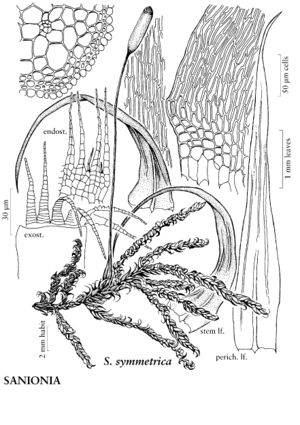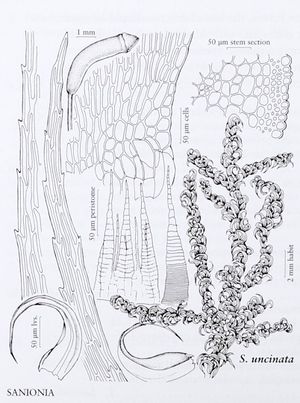Sanionia
Hedwigia 46: 309. 1907.
| Taxon | Illustrator ⠉ | |
|---|---|---|
 | Sanionia orthothecioides | Patricia M. Eckel |
 | Sanionia symmetrica | Patricia M. Eckel |
 | Sanionia uncinata | Patricia M. Eckel |
Plants small to large, green or yellowish green. Stems pinnate ± in one plane or irregularly branched to almost unbranched; hyalodermis present, central strand present; paraphyllia absent; rhizoids or rhizoid initials on stem or abaxial costa insertion, rarely forming tomentum, slightly branched, smooth; axillary hair distal cells 1–8, hyaline. Stem-leaves crowded, circinate, falcate, or almost straight, lanceolate, plicate or rarely not, 0.3–1.7 mm wide; base not or hardly decurrent; margins sometimes incurved proximally, plane or recurved distally, finely denticulate or entire proximally, very finely to strongly denticulate distally, limbidia absent; apex acuminate to very long-acuminate; costa single, ending in acumen; alar cells differentiated, short to long-rectangular, inflated, hyaline, region transversely triangular or ± isodiametric; medial laminal cells linear; marginal cells 1-stratose. Sexual condition autoicous. Capsule horizontal, erect, or inclined, cylindric or short-cylindric, curved to straight; peristome perfect or specialized; exostome teeth margins dentate distally; endostome cilia well developed, rudimentary, or absent. Spores 10–21 µm.
Distribution
North America, Mexico, South America, Eurasia, Africa, Atlantic Islands, Pacific Islands (New Zealand), Australia, Antarctica
Discussion
Species 4 (4 in the flora).
Sanionia is characterized by its well-developed hyalodermis, plicate leaves, hyaline, thin-walled, inflated alar cells forming a transversely triangular or ± isodiametric group, sometimes prorate distal cell ends on the abaxial lamina, and, except in the strongly specialized S. nivalis, very long-acuminate inner perichaetial leaves. Except for S. nivalis, the species generally occur in drier habitats than members of, for example, Drepanocladus, Scorpidium, or Warnstorfia. The other members of the traditional, widely circumscribed genus Drepanocladus in the broad sense that are most closely related to Sanionia are now placed in Drepanocladus and Pseudocalliergon; the latter two genera lack a hyalodermis, have 1–3 rather than 1–8 distal cells of the axillary hairs, and have generally non-plicate rather than plicate leaves. However, because some small phenotypes of Sanionia may also have nearly to entirely non-plicate leaves, the last character should be used with caution. The structures of the alar regions are different, and the exostome margins are more weakly dentate than in S. uncinata, which is the only Sanionia species with an unspecialized peristome. Features separating Sanionia from Hamatocaulis, Loeskypnum, Sarmentypnum, Scorpidium, or Warnstorfia are pointed out in the discussion of 61. Calliergonaceae.
Selected References
None.
Key
| 1 | Stem leaf apices acuminate to long-acuminate; margins strongly denticulate distally; alar regions ± isodiametric, transition to supra-alar cells gradual, supra-alar cells rectangular or long-rectangular, ± echlorophyllose; endostome strongly perforated all over; perichaetial inner leaves ± suddenly narrowed to apex, margins strongly denticulate to dentate distally. | Sanionia nivalis |
| 1 | Stem leaf apices long- to very long-acuminate; margins finely denticulate to denticulate distally; alar regions transversely triangular, transition to supra-alar cells sudden, supra-alar cells quadrate to rectangular, chlorophyllose; endostome perforated only along midline of processes; perichaetial inner leaves gradually narrowed to apex, margins finely denticulate to denticulate distally | > 2 |
| 2 | Stem leaf supra-alar cell walls slightly or strongly incrassate, porose, regions equal in size to or larger than alar region; stem leaf costae in bottom of deep, narrow-angled fold; endostome in recently dehisced capsules strongly yellow, basal membrane 20-30% endostome height. | Sanionia orthothecioides |
| 2 | Stem leaf supra-alar cell walls thin or slightly incrassate, eporose, regions equal in size to or smaller than alar region; stem leaf costae in bottom of shallow, wide-angled fold (or not in fold); endostome in recently dehisced capsules pale, brownish to yellowish, or strongly yellow, basal membrane 25-45% total endostome height | > 3 |
| 3 | Endostome in recently dehisced capsules pale, brownish to yellowish, basal membrane 36-45% total endostome height, cilia well developed; capsules horizontal or rarely erect to inclined. | Sanionia uncinata |
| 3 | Endostome in recently dehisced capsules strongly yellow, basal membrane 25-33% total endostome height, cilia rudimentary; capsules erect or slightly inclined. | Sanionia symmetrica |
"narrower" is not a number.